2009 FORD SUPER DUTY engine oil
[x] Cancel search: engine oilPage 47 of 103

Changing engine oil and filter
Change your oil and filter according to thescheduled maintenance
informationin this supplement. Change more frequently if your vehicle
operation includes extended periods of idling or low-speed operation,
driving for a long time in cold temperatures or driving short distances.
See the following sectionEngine lubrication for severe service
operationfor all severe duty restrictions.
Refer toMotorcraft Part Numberslater in this chapter for the engine oil
filter part number. This filter protects your engine by filtering harmful,
abrasive or sludge particles and particles significantly smaller than most
available “will-fit” filters.
To replace the filter,
1. Unscrew the oil filter cap and wait a few seconds for the oil to drain
through the built-in drain valve.Note:The filter should be changed
before reinstalling the oil pan drain plug.
2. Reinstall and tighten the oil filter cap.
WARNING:Do not handle a hot oil filter with bare hands.
WARNING:Continuous contact with USED motor oil has caused
cancer in laboratory mice. Protect your skin by washing with
soap and water.
Engine lubrication for severe service operation
The following severe service operating conditions require unique engine
maintenance procedures:
•frequent or extended idling (over 10 minutes per hour of normal
driving).
•if vehicle is operated in sustained ambient temperatures below -10°F
(-23°C) or above 100°F (38°C)
•frequent low speed operation, consistent heavy traffic less than
25 mph (40 km/h)
•operating in severe dust conditions.
•towing a trailer over 1,000 miles (1,600 km)
•sustained, high speed driving at Gross Vehicle Weight Rating
(maximum loaded weight for vehicle operation)
2009 Econoline(eco)
Supplement, 1st Printing
USA(fus)
Maintenance and Specifications
47
Page 48 of 103
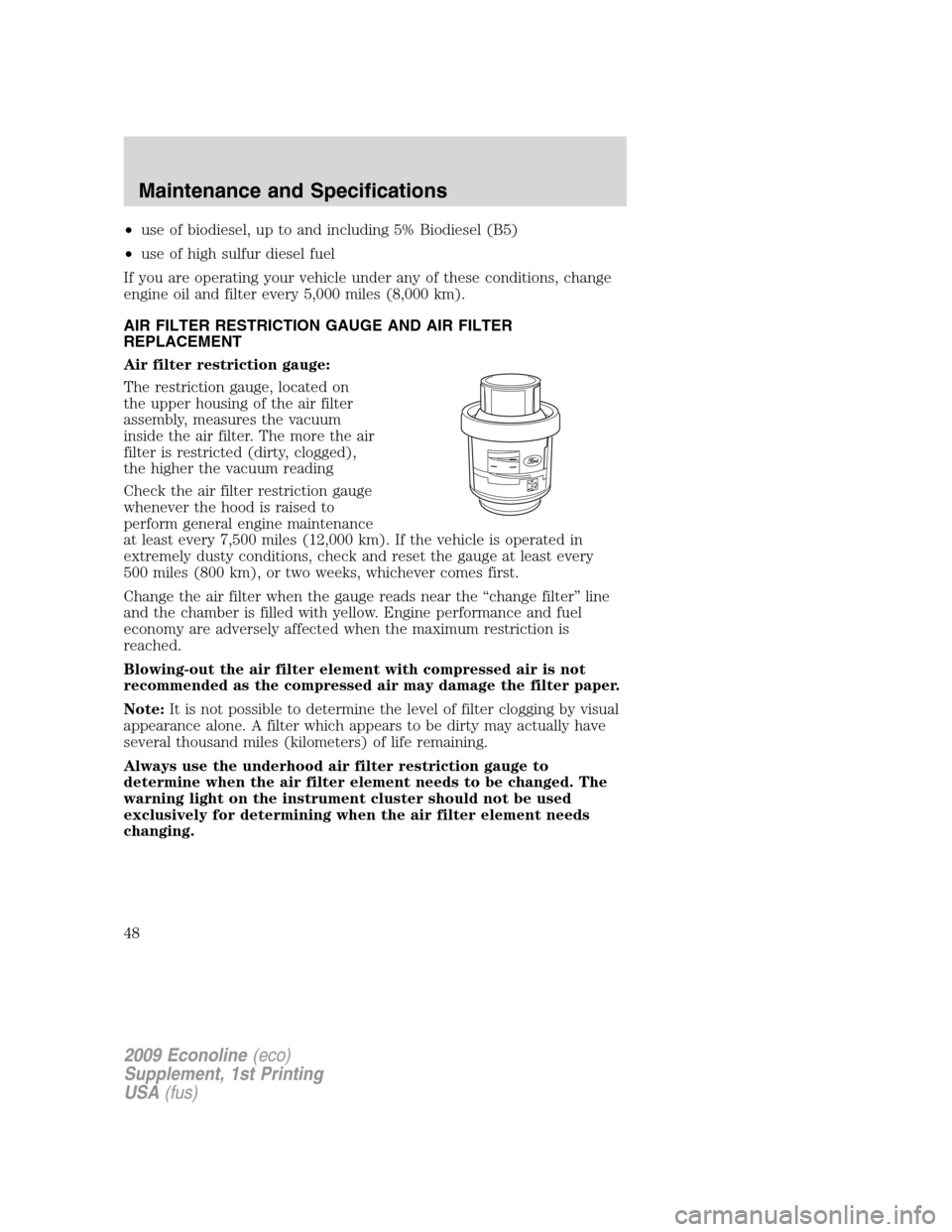
•use of biodiesel, up to and including 5% Biodiesel (B5)
•use of high sulfur diesel fuel
If you are operating your vehicle under any of these conditions, change
engine oil and filter every 5,000 miles (8,000 km).
AIR FILTER RESTRICTION GAUGE AND AIR FILTER
REPLACEMENT
Air filter restriction gauge:
The restriction gauge, located on
the upper housing of the air filter
assembly, measures the vacuum
inside the air filter. The more the air
filter is restricted (dirty, clogged),
the higher the vacuum reading
Check the air filter restriction gauge
whenever the hood is raised to
perform general engine maintenance
at least every 7,500 miles (12,000 km). If the vehicle is operated in
extremely dusty conditions, check and reset the gauge at least every
500 miles (800 km), or two weeks, whichever comes first.
Change the air filter when the gauge reads near the “change filter” line
and the chamber is filled with yellow. Engine performance and fuel
economy are adversely affected when the maximum restriction is
reached.
Blowing-out the air filter element with compressed air is not
recommended as the compressed air may damage the filter paper.
Note:It is not possible to determine the level of filter clogging by visual
appearance alone. A filter which appears to be dirty may actually have
several thousand miles (kilometers) of life remaining.
Always use the underhood air filter restriction gauge to
determine when the air filter element needs to be changed. The
warning light on the instrument cluster should not be used
exclusively for determining when the air filter element needs
changing.
2009 Econoline(eco)
Supplement, 1st Printing
USA(fus)
Maintenance and Specifications
48
Page 55 of 103
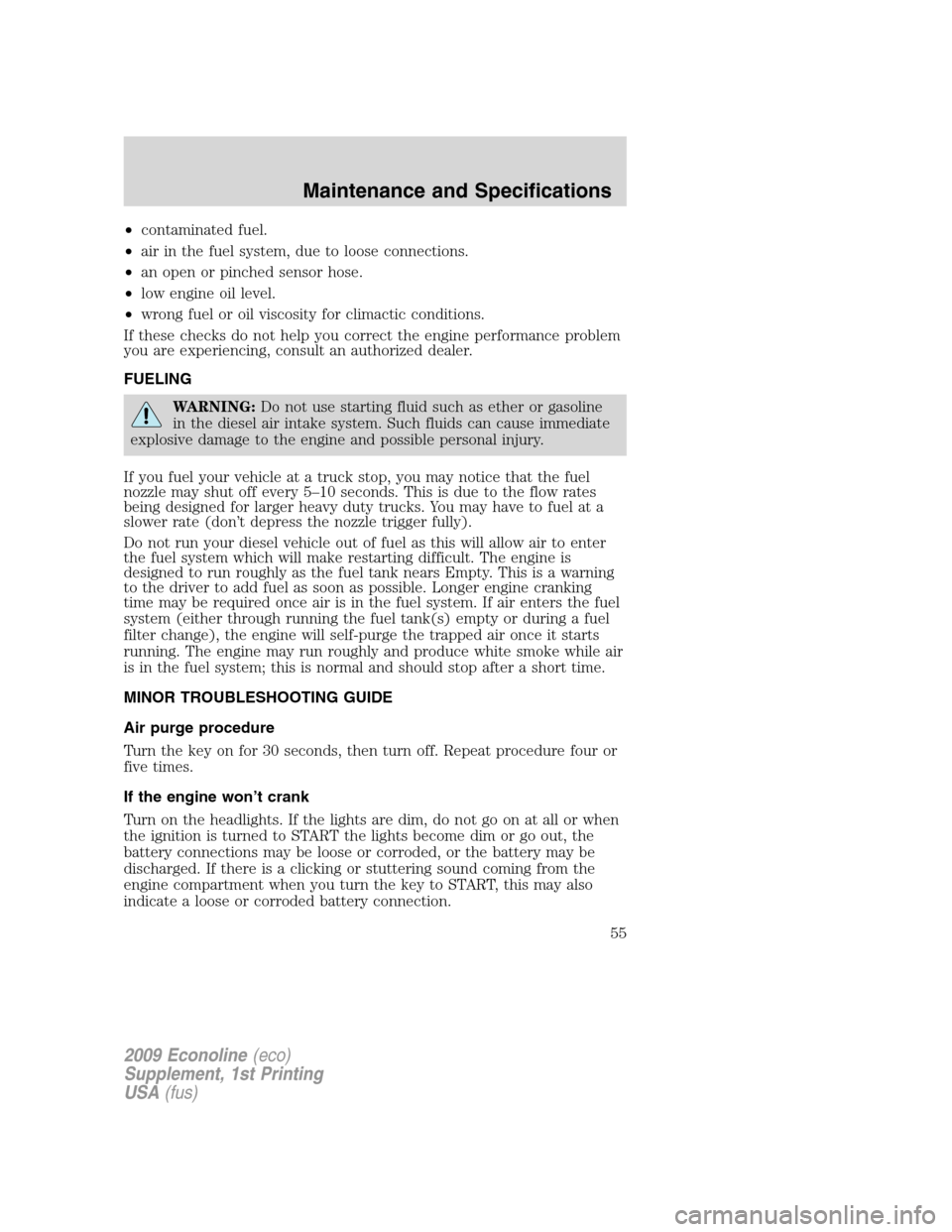
•contaminated fuel.
•air in the fuel system, due to loose connections.
•an open or pinched sensor hose.
•low engine oil level.
•wrong fuel or oil viscosity for climactic conditions.
If these checks do not help you correct the engine performance problem
you are experiencing, consult an authorized dealer.
FUELING
WARNING:Do not use starting fluid such as ether or gasoline
in the diesel air intake system. Such fluids can cause immediate
explosive damage to the engine and possible personal injury.
If you fuel your vehicle at a truck stop, you may notice that the fuel
nozzle may shut off every 5–10 seconds. This is due to the flow rates
being designed for larger heavy duty trucks. You may have to fuel at a
slower rate (don’t depress the nozzle trigger fully).
Do not run your diesel vehicle out of fuel as this will allow air to enter
the fuel system which will make restarting difficult. The engine is
designed to run roughly as the fuel tank nears Empty. This is a warning
to the driver to add fuel as soon as possible. Longer engine cranking
time may be required once air is in the fuel system. If air enters the fuel
system (either through running the fuel tank(s) empty or during a fuel
filter change), the engine will self-purge the trapped air once it starts
running. The engine may run roughly and produce white smoke while air
is in the fuel system; this is normal and should stop after a short time.
MINOR TROUBLESHOOTING GUIDE
Air purge procedure
Turn the key on for 30 seconds, then turn off. Repeat procedure four or
five times.
If the engine won’t crank
Turn on the headlights. If the lights are dim, do not go on at all or when
the ignition is turned to START the lights become dim or go out, the
battery connections may be loose or corroded, or the battery may be
discharged. If there is a clicking or stuttering sound coming from the
engine compartment when you turn the key to START, this may also
indicate a loose or corroded battery connection.
2009 Econoline(eco)
Supplement, 1st Printing
USA(fus)
Maintenance and Specifications
55
Page 56 of 103
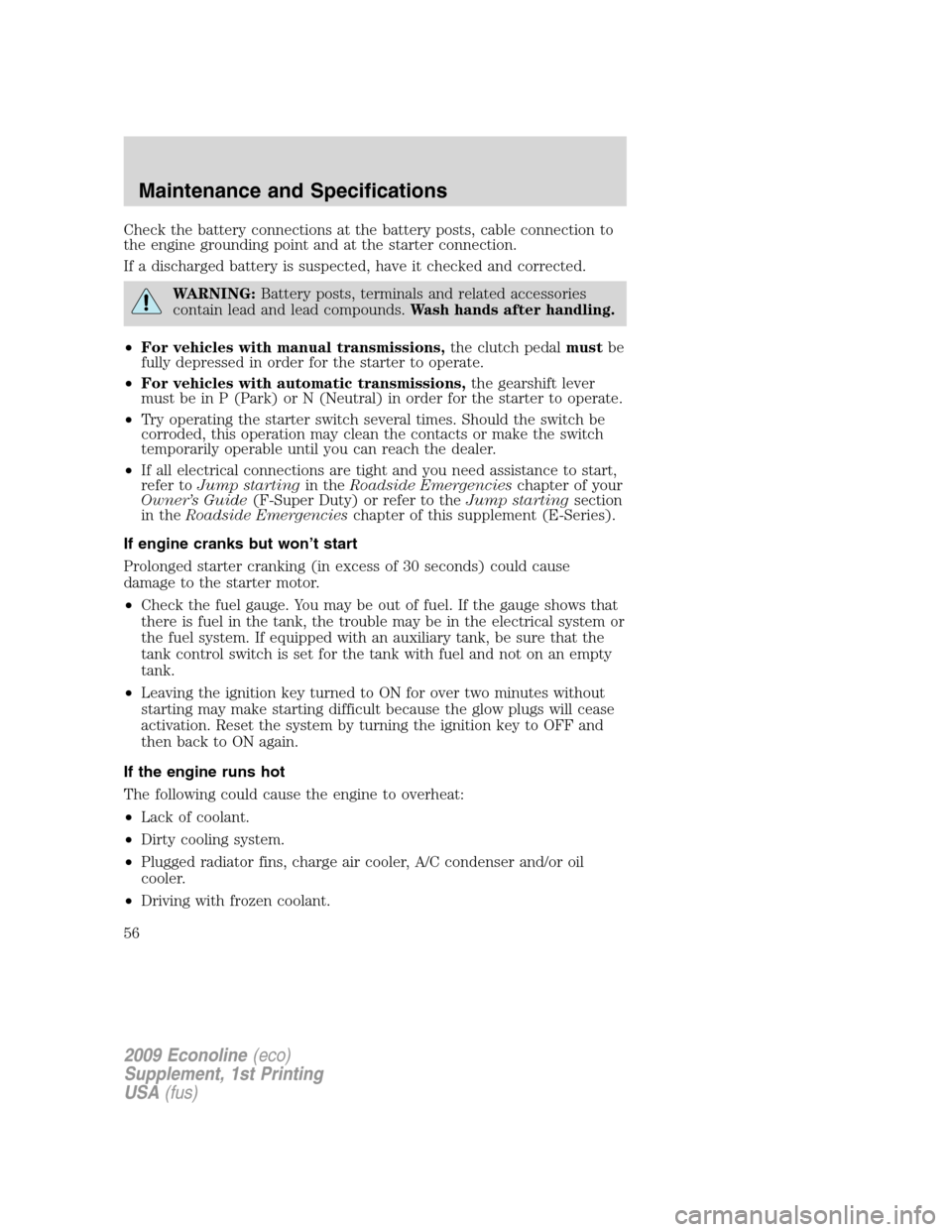
Check the battery connections at the battery posts, cable connection to
the engine grounding point and at the starter connection.
If a discharged battery is suspected, have it checked and corrected.
WARNING:Battery posts, terminals and related accessories
contain lead and lead compounds.Wash hands after handling.
•For vehicles with manual transmissions,the clutch pedalmustbe
fully depressed in order for the starter to operate.
•For vehicles with automatic transmissions,the gearshift lever
must be in P (Park) or N (Neutral) in order for the starter to operate.
•Try operating the starter switch several times. Should the switch be
corroded, this operation may clean the contacts or make the switch
temporarily operable until you can reach the dealer.
•If all electrical connections are tight and you need assistance to start,
refer toJump startingin theRoadside Emergencieschapter of your
Owner’s Guide(F-Super Duty) or refer to theJump startingsection
in theRoadside Emergencieschapter of this supplement (E-Series).
If engine cranks but won’t start
Prolonged starter cranking (in excess of 30 seconds) could cause
damage to the starter motor.
•Check the fuel gauge. You may be out of fuel. If the gauge shows that
there is fuel in the tank, the trouble may be in the electrical system or
the fuel system. If equipped with an auxiliary tank, be sure that the
tank control switch is set for the tank with fuel and not on an empty
tank.
•Leaving the ignition key turned to ON for over two minutes without
starting may make starting difficult because the glow plugs will cease
activation. Reset the system by turning the ignition key to OFF and
then back to ON again.
If the engine runs hot
The following could cause the engine to overheat:
•Lack of coolant.
•Dirty cooling system.
•Plugged radiator fins, charge air cooler, A/C condenser and/or oil
cooler.
•Driving with frozen coolant.
2009 Econoline(eco)
Supplement, 1st Printing
USA(fus)
Maintenance and Specifications
56
Page 57 of 103
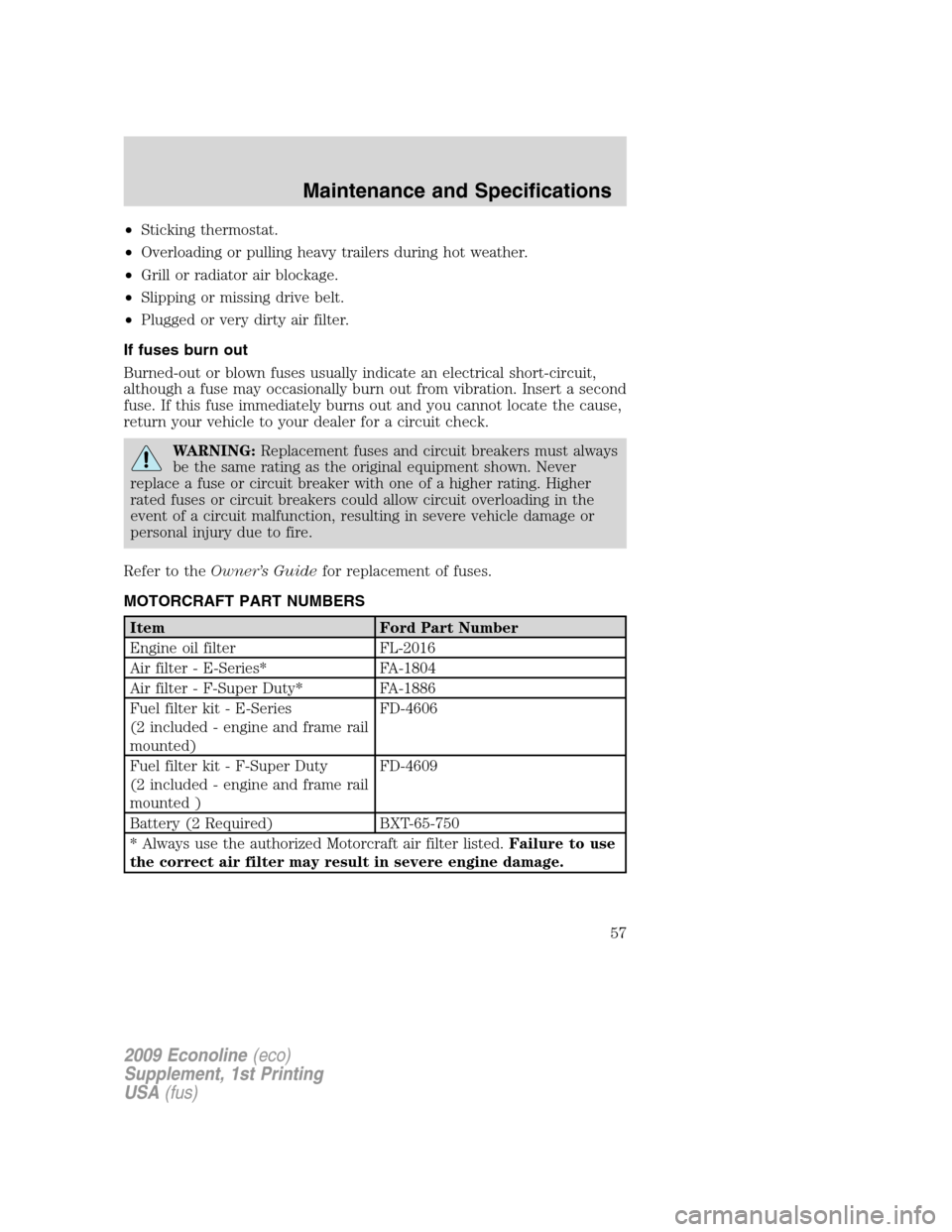
•Sticking thermostat.
•Overloading or pulling heavy trailers during hot weather.
•Grill or radiator air blockage.
•Slipping or missing drive belt.
•Plugged or very dirty air filter.
If fuses burn out
Burned-out or blown fuses usually indicate an electrical short-circuit,
although a fuse may occasionally burn out from vibration. Insert a second
fuse. If this fuse immediately burns out and you cannot locate the cause,
return your vehicle to your dealer for a circuit check.
WARNING:Replacement fuses and circuit breakers must always
be the same rating as the original equipment shown. Never
replace a fuse or circuit breaker with one of a higher rating. Higher
rated fuses or circuit breakers could allow circuit overloading in the
event of a circuit malfunction, resulting in severe vehicle damage or
personal injury due to fire.
Refer to theOwner’s Guidefor replacement of fuses.
MOTORCRAFT PART NUMBERS
Item Ford Part Number
Engine oil filter FL-2016
Air filter - E-Series* FA-1804
Air filter - F-Super Duty* FA-1886
Fuel filter kit - E-Series
(2 included - engine and frame rail
mounted)FD-4606
Fuel filter kit - F-Super Duty
(2 included - engine and frame rail
mounted )FD-4609
Battery (2 Required) BXT-65-750
* Always use the authorized Motorcraft air filter listed.Failure to use
the correct air filter may result in severe engine damage.
2009 Econoline(eco)
Supplement, 1st Printing
USA(fus)
Maintenance and Specifications
57
Page 58 of 103
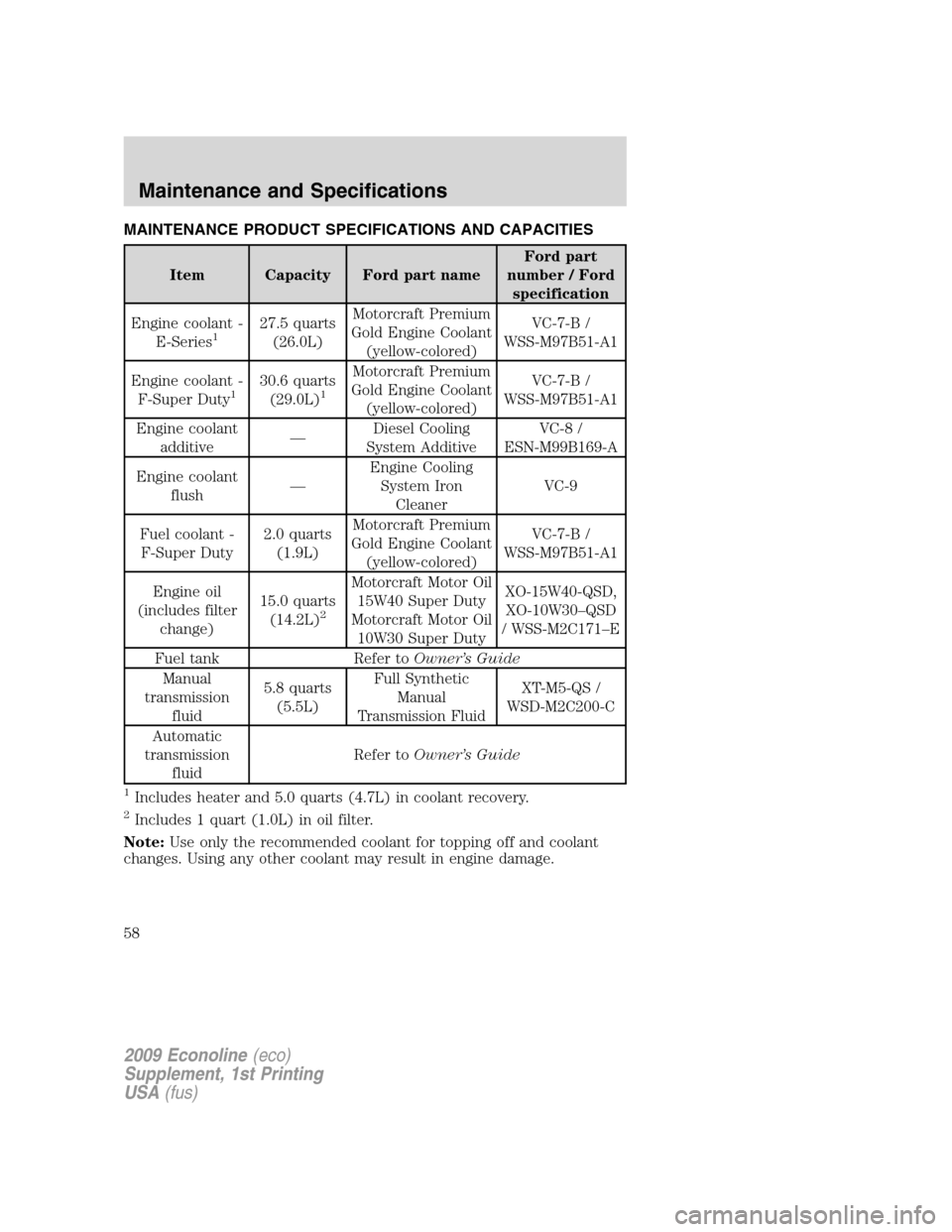
MAINTENANCE PRODUCT SPECIFICATIONS AND CAPACITIES
Item Capacity Ford part nameFord part
number / Ford
specification
Engine coolant -
E-Series
127.5 quarts
(26.0L)Motorcraft Premium
Gold Engine Coolant
(yellow-colored)VC-7-B /
WSS-M97B51-A1
Engine coolant -
F-Super Duty
130.6 quarts
(29.0L)1
Motorcraft Premium
Gold Engine Coolant
(yellow-colored)VC-7-B /
WSS-M97B51-A1
Engine coolant
additive—Diesel Cooling
System AdditiveVC-8 /
ESN-M99B169-A
Engine coolant
flush—Engine Cooling
System Iron
CleanerVC-9
Fuel coolant -
F-Super Duty2.0 quarts
(1.9L)Motorcraft Premium
Gold Engine Coolant
(yellow-colored)VC-7-B /
WSS-M97B51-A1
Engine oil
(includes filter
change)15.0 quarts
(14.2L)
2
Motorcraft Motor Oil
15W40 Super Duty
Motorcraft Motor Oil
10W30 Super DutyXO-15W40-QSD,
XO-10W30–QSD
/ WSS-M2C171–E
Fuel tank Refer toOwner’s Guide
Manual
transmission
fluid5.8 quarts
(5.5L)Full Synthetic
Manual
Transmission FluidXT-M5-QS /
WSD-M2C200-C
Automatic
transmission
fluidRefer toOwner’s Guide
1Includes heater and 5.0 quarts (4.7L) in coolant recovery.
2Includes 1 quart (1.0L) in oil filter.
Note:Use only the recommended coolant for topping off and coolant
changes. Using any other coolant may result in engine damage.
2009 Econoline(eco)
Supplement, 1st Printing
USA(fus)
Maintenance and Specifications
58
Page 59 of 103
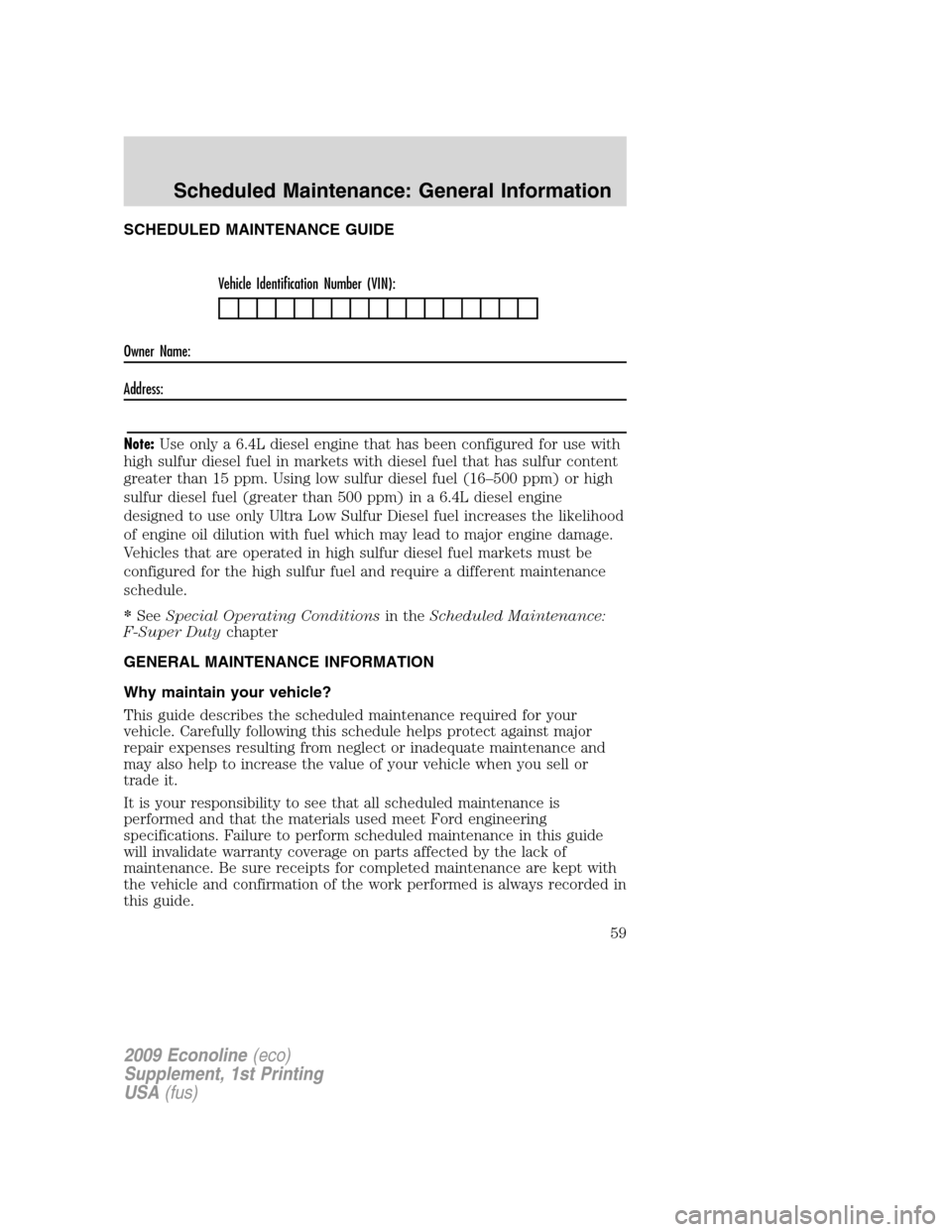
SCHEDULED MAINTENANCE GUIDE
Vehicle Identification Number (VIN):
Owner Name:
Address:
Note:Use only a 6.4L diesel engine that has been configured for use with
high sulfur diesel fuel in markets with diesel fuel that has sulfur content
greater than 15 ppm. Using low sulfur diesel fuel (16–500 ppm) or high
sulfur diesel fuel (greater than 500 ppm) in a 6.4L diesel engine
designed to use only Ultra Low Sulfur Diesel fuel increases the likelihood
of engine oil dilution with fuel which may lead to major engine damage.
Vehicles that are operated in high sulfur diesel fuel markets must be
configured for the high sulfur fuel and require a different maintenance
schedule.
*SeeSpecial Operating Conditionsin theScheduled Maintenance:
F-Super Dutychapter
GENERAL MAINTENANCE INFORMATION
Why maintain your vehicle?
This guide describes the scheduled maintenance required for your
vehicle. Carefully following this schedule helps protect against major
repair expenses resulting from neglect or inadequate maintenance and
may also help to increase the value of your vehicle when you sell or
trade it.
It is your responsibility to see that all scheduled maintenance is
performed and that the materials used meet Ford engineering
specifications. Failure to perform scheduled maintenance in this guide
will invalidate warranty coverage on parts affected by the lack of
maintenance. Be sure receipts for completed maintenance are kept with
the vehicle and confirmation of the work performed is always recorded in
this guide.
2009 Econoline(eco)
Supplement, 1st Printing
USA(fus)
Scheduled Maintenance: General Information
59
Page 60 of 103
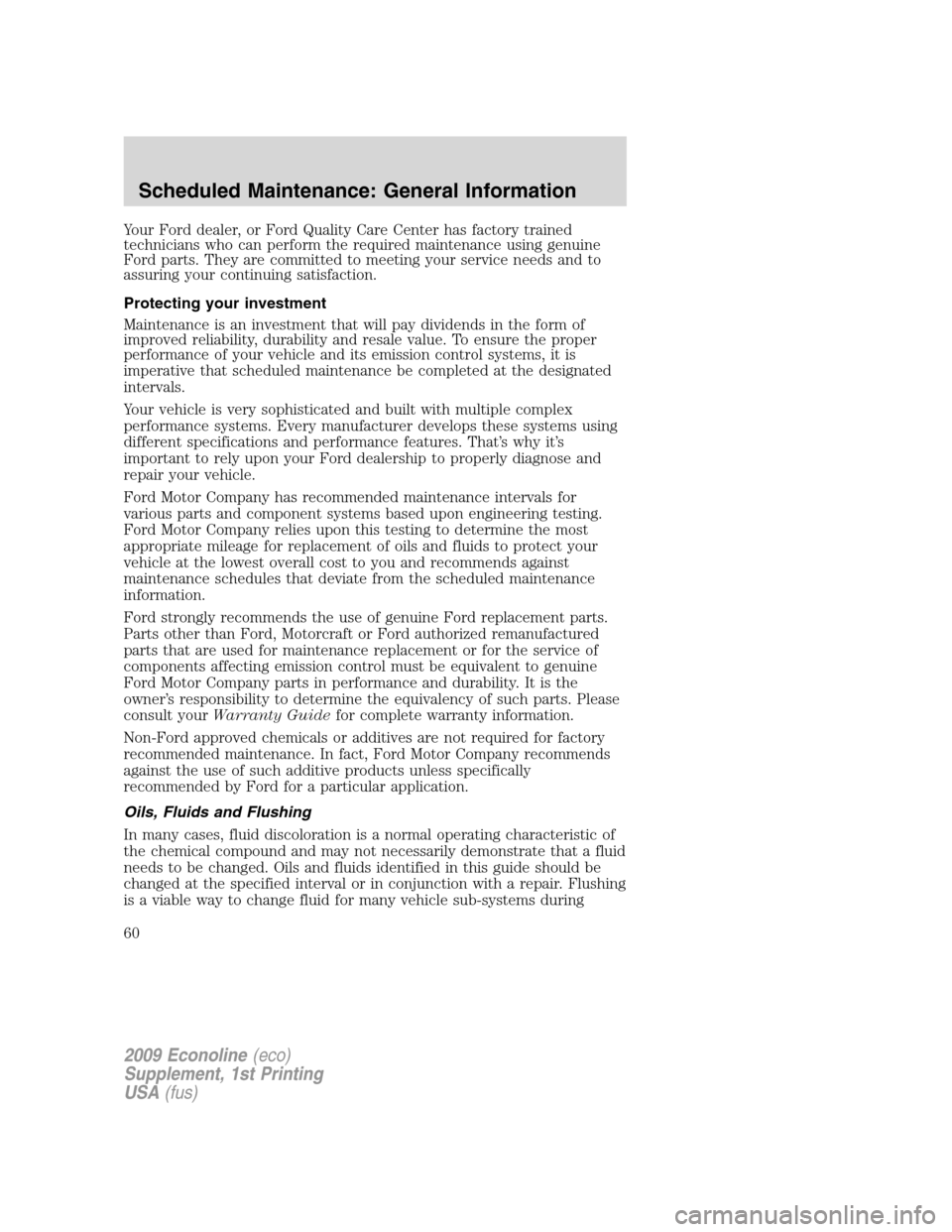
Your Ford dealer, or Ford Quality Care Center has factory trained
technicians who can perform the required maintenance using genuine
Ford parts. They are committed to meeting your service needs and to
assuring your continuing satisfaction.
Protecting your investment
Maintenance is an investment that will pay dividends in the form of
improved reliability, durability and resale value. To ensure the proper
performance of your vehicle and its emission control systems, it is
imperative that scheduled maintenance be completed at the designated
intervals.
Your vehicle is very sophisticated and built with multiple complex
performance systems. Every manufacturer develops these systems using
different specifications and performance features. That’s why it’s
important to rely upon your Ford dealership to properly diagnose and
repair your vehicle.
Ford Motor Company has recommended maintenance intervals for
various parts and component systems based upon engineering testing.
Ford Motor Company relies upon this testing to determine the most
appropriate mileage for replacement of oils and fluids to protect your
vehicle at the lowest overall cost to you and recommends against
maintenance schedules that deviate from the scheduled maintenance
information.
Ford strongly recommends the use of genuine Ford replacement parts.
Parts other than Ford, Motorcraft or Ford authorized remanufactured
parts that are used for maintenance replacement or for the service of
components affecting emission control must be equivalent to genuine
Ford Motor Company parts in performance and durability. It is the
owner’s responsibility to determine the equivalency of such parts. Please
consult yourWarranty Guidefor complete warranty information.
Non-Ford approved chemicals or additives are not required for factory
recommended maintenance. In fact, Ford Motor Company recommends
against the use of such additive products unless specifically
recommended by Ford for a particular application.
Oils, Fluids and Flushing
In many cases, fluid discoloration is a normal operating characteristic of
the chemical compound and may not necessarily demonstrate that a fluid
needs to be changed. Oils and fluids identified in this guide should be
changed at the specified interval or in conjunction with a repair. Flushing
is a viable way to change fluid for many vehicle sub-systems during
2009 Econoline(eco)
Supplement, 1st Printing
USA(fus)
Scheduled Maintenance: General Information
60